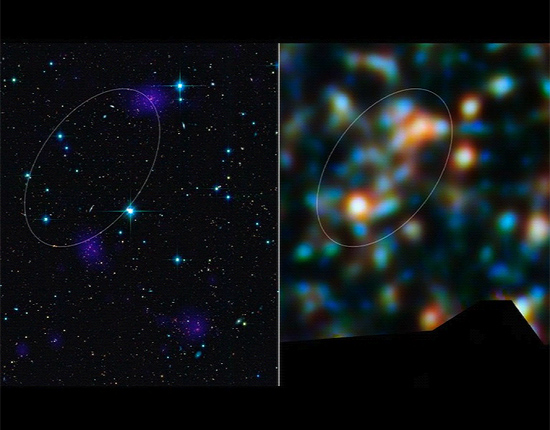
Clusters of galaxies on the same electric Birkeland current filament. Credit: ESA/NASA/JPL-Caltech/CXC/McGill University
May 18, 2012
A galaxy-wide filament connects two galactic clusters.
The Herschel Space Observatory possesses the largest mirror ever launched into space: 3.5 meters in diameter. Herschel entered orbit around LaGrange point L2 (behind Earth in relation to the Sun) in July 2009, so that its extremely sensitive, supercooled infrared detectors could be protected from solar radiation. However, Herschel’s helium coolant system was built to last only three years, so marking its May 14, 2009 launch date, the helium tanks will be exhausted this month.
According to a recent press release, astronomers working with the Herschel Space Observatory telescope are witnessing the “evolution of cosmic structure” in deep space.
Two of the three galaxy clusters within the RCS 2319+00 supercluster at z=0.9 (about 7 billion light-years away as astronomers reckon distance) are connected by a “luminous bridge” containing billions of stars. The 8.15 million light-year long filament is host to a large number of galaxies radiating in the mid-infrared range. The only way for astronomers to see stars (or galaxies) inside dusty environments is to view them in infrared light. Although the galaxies within the filament radiate in the 200-500 micron frequency range, the clusters connected by it are strong X-ray sources.
According to Electric Universe theory, galactic evolution occurs as large-scale plasma discharges form coherent filaments that exhibit electrodynamic behavior. Gravity certainly contributes to the behavior of star clusters and galaxies but it is not the primary energy source for their consolidation. Stars in galaxies can form long arcs like silver beads on a string, threading through galaxies for great distances.
When plasma moves through a cloud of dust and gas, the cloud becomes ionized, initiating an electric field and the flow of electric charge. Electricity moving through any substance forms magnetic fields that tend to align and constrict the current flow. Those fields create what are sometimes called “plasma ropes,” otherwise known as Birkeland currents.
Birkeland currents are electromagnetic filaments that carry electric charges through space. The filaments isolate regions of opposite charge and prevent them from neutralizing. Almost every body in the Universe displays some kind of filamentation. Planetary nebulae are spun from intricate webs of lighted tendrils. Herbig-Haro stars and energetic galaxies emit braided jets. Some galaxies look “hairy,” with threads of material extending from them.
Since the various loads in galactic circuits radiate energy, they must be powered by coupling with larger circuits. How large those circuits are can be inferred by the observation that galaxies can occur in strings, and are also joined together by filaments, as RCS 2319+00 demonstrates.
The standard model of the Universe places galaxies within the void according to redshift (z). Some astronomical observations contradict the conventional view, however. High-z objects are seen to be aligned along the axes of low redshift galaxies, their redshifts decreasing stepwise with distance along the axis. These high-z objects also demonstrate an increase in mass and luminosity with distance. There is some fundamental physics involved here that does not appear in any textbook.
Presumptions are difficult to overcome, particularly when they represent the sine qua non of thought within a specific discipline. The inability of conventional researchers to understand several factors hampers their ability to grasp the fundamental nature of the cosmos. Two of the most pressing issues in the modern approach to understanding the Universe are the adherence to redshift as the only tool for estimating distances and ages of stars and galaxies, and a lack of knowledge when it comes to electricity.
For this reason, while the consensus scientific worldview only permits isolated galactic “islands” in space, the Electric Universe hypothesis emphasizes connectivity with a vast network of electrically active “transmission lines.” That spatial wiring is composed of Birkeland currents.
Astronomer Halton Arp’s work has shown that there are connections between high-redshift objects (supposedly far away) and low-redshift galaxies. Since the “distant” objects are really companions of nearby galaxies, then what is visible outside the Milky Way is part of a “stringy” galactic grouping.
The strings are the aforementioned Birkeland current filaments millions of light years thick and billions of light years long, out of which groups of galaxies are “pinched.” Arp raises the possibility that the visible Universe is one braided filament extending from the Virgo supercluster to the Fornax supercluster across billions of light years. This power line carries electric currents beyond anything we can imagine.
Stephen Smith
Hat tip to William I. Thompson III












